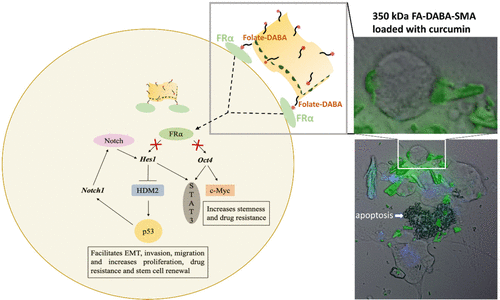当前位置:
X-MOL 学术
›
Bioconjugate Chem.
›
论文详情
Our official English website, www.x-mol.net, welcomes your
feedback! (Note: you will need to create a separate account there.)
Folic Acid-Functionalized Nanomedicine: Folic Acid Conjugated Copolymer and Folate Receptor Interactions Disrupt Receptor Functionality Resulting in Dual Therapeutic Anti-Cancer Potential in Breast and Prostate Cancer
Bioconjugate Chemistry ( IF 4.0 ) Pub Date : 2021-02-08 , DOI: 10.1021/acs.bioconjchem.0c00625 Alexandria DeCarlo 1 , Cecile Malardier-Jugroot 2 , Myron R Szewczuk 1
Bioconjugate Chemistry ( IF 4.0 ) Pub Date : 2021-02-08 , DOI: 10.1021/acs.bioconjchem.0c00625 Alexandria DeCarlo 1 , Cecile Malardier-Jugroot 2 , Myron R Szewczuk 1
Affiliation

|
We have previously reported on a functionalized folic acid (FA) conjugated poly(styrene-alt-maleic anhydride) (SMA) via biological linker 2,4-diaminobutyric acid (DABA) (FA–DABA–SMA) copolymer. This biocompatible nanocopolymer self-assembles in a pH-dependent manner, providing stimuli responsiveness, active targeting, and extended release of hydrophobic chemotherapeutic agents and effectively penetrates the inner core of 3-dimensional cancer spheroid models. The empty FA–DABA–SMA decreased tumor spheroid volume, revealing a previously unknown mechanism of action. Here, we investigated the potential mechanism of the small (20 kDa) and large (350 kDa) FA–DABA–SMA empty copolymers affecting the folic acid receptor alpha (FRα) signaling properties in breast and prostate cancer cell lines. Microscopic imaging, immunocytochemistry, flow cytometry, Caspase 3/7 apoptosis assays, Incucyte live cell tracking, the scratch wound assay, the water-soluble tetrazolium salt-1 (WST-1) cell viability assay, morphologic changes, and Western blot for the expression levels of FRα on the cell surface were used on MDA MB-231 and MCF-7 breast and DU-145 prostate cancer cell lines. The findings indicate that FA–DABA–SMA increases FRα expression levels in breast MDA MB-231 cancer cells and then disrupts FR signaling by reducing HES1 and NOTCH1 protein expression levels. Also, FA–DABA–SMA induces apoptosis and further causes a change in the MDA MB-231 cells’ morphology and significantly reduces their ability to migrate in a scratch wound assay. Collectively, these findings provide a novel insight into the functionalized FA–DABA–SMA copolymer. The 350 and 20 kDa copolymers actively target FRα to initialize internationalization. However, only the large size and sheet-shaped 350 kDa copolymers disrupt FRα signaling. The significance of these novel findings reveals that the copolymer’s intracellular activity is critically dependent on the size and structural shape. This report offers novel therapeutic insight into a dual mechanism of the FA–DABA–SMA copolymer for its therapeutic potential to treat cancer.
中文翻译:

叶酸功能化纳米医学:叶酸共轭共聚物和叶酸受体相互作用破坏受体功能,导致乳腺癌和前列腺癌的双重治疗抗癌潜力
我们之前曾报道过功能化叶酸 (FA) 共轭聚(苯乙烯-alt-马来酸酐)(SMA)通过生物接头 2,4-二氨基丁酸(DABA)(FA-DABA-SMA)共聚物。这种生物相容性纳米共聚物以 pH 依赖性方式自组装,提供刺激响应性、主动靶向和疏水性化学治疗剂的延长释放,并有效渗透 3 维癌症球体模型的内核。空的 FA-DABA-SMA 减少了肿瘤球体体积,揭示了以前未知的作用机制。在这里,我们研究了小 (20 kDa) 和大 (350 kDa) FA-DABA-SMA 空共聚物影响乳腺癌和前列腺癌细胞系中叶酸受体α (FRα) 信号传导特性的潜在机制。显微成像、免疫细胞化学、流式细胞术、Caspase 3/7 细胞凋亡分析、Incucyte 活细胞追踪、划痕分析、在 MDA MB-231 和 MCF-7 乳腺和 DU-145 前列腺上使用水溶性四唑盐-1 (WST-1) 细胞活力测定、形态学变化和细胞表面 FRα 表达水平的蛋白质印迹癌细胞系。研究结果表明,FA-DABA-SMA 增加了乳腺癌 MDA MB-231 癌细胞中 FRα 的表达水平,然后通过降低 HES1 和 NOTCH1 蛋白表达水平来破坏 FR 信号传导。此外,FA-DABA-SMA 诱导细胞凋亡并进一步引起 MDA MB-231 细胞形态的变化,并显着降低其在划痕试验中的迁移能力。总的来说,这些发现为功能化的 FA-DABA-SMA 共聚物提供了新的见解。350 和 20 kDa 共聚物积极针对 FRα 以初始化国际化。然而,只有大尺寸和片状的 350 kDa 共聚物会破坏 FRα 信号。这些新发现的意义表明共聚物的细胞内活性严重依赖于尺寸和结构形状。该报告为 FA-DABA-SMA 共聚物的双重机制提供了新的治疗见解,因为它具有治疗癌症的潜力。
更新日期:2021-03-17
中文翻译:

叶酸功能化纳米医学:叶酸共轭共聚物和叶酸受体相互作用破坏受体功能,导致乳腺癌和前列腺癌的双重治疗抗癌潜力
我们之前曾报道过功能化叶酸 (FA) 共轭聚(苯乙烯-alt-马来酸酐)(SMA)通过生物接头 2,4-二氨基丁酸(DABA)(FA-DABA-SMA)共聚物。这种生物相容性纳米共聚物以 pH 依赖性方式自组装,提供刺激响应性、主动靶向和疏水性化学治疗剂的延长释放,并有效渗透 3 维癌症球体模型的内核。空的 FA-DABA-SMA 减少了肿瘤球体体积,揭示了以前未知的作用机制。在这里,我们研究了小 (20 kDa) 和大 (350 kDa) FA-DABA-SMA 空共聚物影响乳腺癌和前列腺癌细胞系中叶酸受体α (FRα) 信号传导特性的潜在机制。显微成像、免疫细胞化学、流式细胞术、Caspase 3/7 细胞凋亡分析、Incucyte 活细胞追踪、划痕分析、在 MDA MB-231 和 MCF-7 乳腺和 DU-145 前列腺上使用水溶性四唑盐-1 (WST-1) 细胞活力测定、形态学变化和细胞表面 FRα 表达水平的蛋白质印迹癌细胞系。研究结果表明,FA-DABA-SMA 增加了乳腺癌 MDA MB-231 癌细胞中 FRα 的表达水平,然后通过降低 HES1 和 NOTCH1 蛋白表达水平来破坏 FR 信号传导。此外,FA-DABA-SMA 诱导细胞凋亡并进一步引起 MDA MB-231 细胞形态的变化,并显着降低其在划痕试验中的迁移能力。总的来说,这些发现为功能化的 FA-DABA-SMA 共聚物提供了新的见解。350 和 20 kDa 共聚物积极针对 FRα 以初始化国际化。然而,只有大尺寸和片状的 350 kDa 共聚物会破坏 FRα 信号。这些新发现的意义表明共聚物的细胞内活性严重依赖于尺寸和结构形状。该报告为 FA-DABA-SMA 共聚物的双重机制提供了新的治疗见解,因为它具有治疗癌症的潜力。











































 京公网安备 11010802027423号
京公网安备 11010802027423号